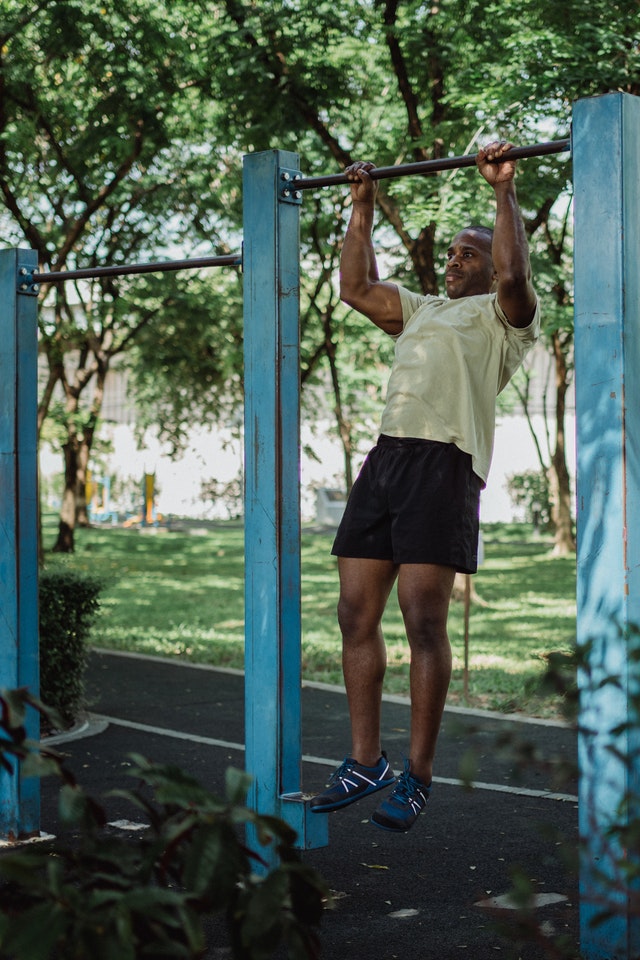This post may contain affiliate links. Please read the disclaimer for more information.
I honestly love pullups but I’ve come to find out they’ve been doing me wrong.
Whenever I do them, I’m sore in my biceps, elbow, and forearms. All the load is getting dumped into those areas and that’s not what I want. In fact, that’s not what anybody wants.
I should be feeling it in my lats, mid-back, and traps mostly. The fact that time after time, my arms are getting completely isolated while doing pullups is an obvious sign that I’m not doing them correctly.
After wondering about this for a short time, I had somewhat of a realization about what the movement is really for.
Pullups are intended to recruit many different muscle groups, but primarily the back muscles. This is why people really do them.
I thought about how I was doing them and putting together in my head that the reason I’m isolating these smaller muscle groups in my arms and getting so sore from them is that I’m not completing the movement. I’m not doing the pullup as it’s meant to be done.
These have been one major reasons why I started doing my inner arm release technique that has saved me a lot of pain.
I feel that many other people would also be in the same boat. I will watch lots of people do pullups at the gym and it doesn’t look like they’re getting the full range of movement in either.
So what is the full range of movement? Aren’t pullups just a matter of getting your chin to the bar?
No, that’s precisely where most of us are wrong.
That’s what we want it to be so we can say “I do this many pullups.” But really, it can get very sloppy in how you get your chin over the bar.
It’s all about how you do it.
When you are almost at the point of having your chin pass the bar, you should be squeezing your back muscles so the shoulder blades come together. That’s how you actually engage your back.

This is a good example of how the end range of a pullup should look. He’s not trying to lift his chin above the bar, he’s actually bringing his chest to the bar in order to contract his back muscles properly.
The problem is, most of us aren’t actually strong enough to do that while at the end range of this movement where we’re supporting all of our bodyweight at the top of the bar. Pullups are a simple movement, but not an easy one. It can be very hard to control your full bodyweight entirely on your own power to do the technique properly.
I can say that I’ll do 7 pullups in a row. I’m proud to say that, however, this is without proper back muscle engagement.
The goal shouldn’t be to make your chin pass the bar a certain amount of times, it should be to do the movement correctly even if it’s only once.
This is what an elite training program like Movement 20XX from Vahva Fitness will teach you: focus on the quality of your movement rather than the quantity. Or as they say:
“Previously you have probably counted the repetitions, but this time you need to make the repetitions count!”
So in light of this advice from Vahva Fitness, I have decided to take a step back from pullups and instead use the assisted pullup machine. I am now doing this because I can choose how much of my bodyweight the machine will support to make sure that I can do the pullups properly.
Now, I’ve been able to have my chin pass the bar like before, but also squeeze my back muscles while I’m at the top for maximum engagement.
Because of this, I have been noticeably less sore in my arms. More importantly, and what I’m very proud of, is that I am now sore in the center of my back which is the exact result I wanted.
This is an adaptation I will stick with for as long as I need to make sure I build a strong foundation so that when I do come back to standard pullups, I will be doing them correctly.
I’ve said it before and I’ll say it again, the athlete’s journey is often a bumpy road with many twists and turns. It’s all about how you adapt. If you can pivot, you will succeed and grow.


Leave a Reply